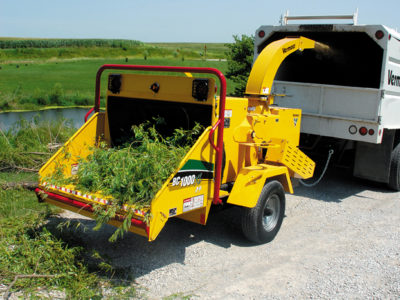Environmental responsibility — it’s become a rallying cry to take a personal role in helping to protect and improve the environment. The movement has permeated all aspects of our personal and working lives. In fact, the green movement is becoming more apparent in the tree care industry as suppliers bring products to market that have been built with sustainability in mind.
Manufacturers have been exploring ways to design and build tree care equipment that has a smaller impact on the environment, and today these ideas are becoming a reality — brush chippers and stump cutters that are cleaner-burning, more efficient and made from recycled products.
Obviously, some of these changes are being driven by regulations. However, many manufacturers are taking the green movement one step further by integrating recycled materials into the design of their equipment and exploring ways to streamline the manufacturing process.
The main drivers for these changes are government mandates that regulate engine emissions. Brush chippers are being repowered to meet these requirements and impending regulatory deadlines, but it challenges engineering teams. It’s not as easy as dropping a new engine into a chipper.
“It’s not to the point of building a new brush chipper from the ground up,” says Todd Roorda, tree care sales manager for Vermeer Corporation. “But it isn’t that far off because the engine is the main cog in how a brush chipper works. So many of the other components are affected, including the intake and exhaust systems and the cooling package.”
These cleaner-burning engines run warmer and require a larger cooling package to help the engine maintain its desired efficiency. Adding a larger cooling package creates space constraints causing other logistic issues. It’s an engineering task that takes quite a bit of time.
One step taking place in the brush chipper industry is the use of lower-horsepower engines. Many states, like California, have strict guidelines on emissions and this has required manufacturers to explore the use of smaller engines in their current chipper models. This brings up a major question among tree care contractors — how can a 12-inch (30.5 cm) brush chipper that was powered by an 85 horsepower (63.4 kW) engine achieve the same productivity with a 49 horsepower (36.5 kW) engine?
“To be honest, that’s the first reaction many customers are going to have,” says Roorda. “But the engine is only one part of the chipper that delivers productivity. Manufacturers are building smarter chippers — chippers that feature sensors that monitor engine rpm and automatically stop or reverse the feed rollers when feeding large, hardwood material. These systems, when combined with a small-horsepower engine, may kick in more often, but the unit will still be able to process the material in an efficient and productive manner.”
Once the government mandates have been met, many manufacturers have another set of internal standards that need to be met.
“Our brush chippers will undergo another set of performance measures to ensure the machines will function properly in different types of climates and conditions,” says Roorda. “It’s just another step to ensure the units meet customer needs.”
Manufacturers aren’t focused only on more efficient engines. Vermeer has started to use recycled steel in the manufacture of some of their products. Plus, some manufacturers, including Vermeer, are looking for ways to design chippers with a reduced overall weight of the machine, such as lighter steel and the integration of plastics or rubber in certain components. Reducing the overall weight of the machine may lead to the use of a smaller towing vehicle.
“Today’s technology allows us to build a chipper with less steel, but still provide the durability customers expect,” says Roorda. “We’ve also made a conscious effort to begin to incorporate engine hoods and shields made from recycled ABS plastic into the design of our chippers. These molded shields are one more way to expand our green efforts.”
Environmental responsibility isn’t only in the hands of the manufacturers; tree care contractors have a role as well.
Time management is something that most contractors should explore. Take the time to plan your day to reduce unnecessary travel from one end of the city to the other. It doesn’t always work out, but if there are work sites closer, you can save time, energy and fuel with a defined work plan. Another area for consideration is shutting down the chipper when it’s not in use for long periods of time. This in the long run can equate to lower emissions since less time may be spent traveling from site to site and running the chipper less when no work is being performed.
“Overall, greener machines are better for the environment,” says Roorda. “By itself one greener machine won’t have a significant impact on the environment, but combined with other efforts it can help reduce emissions and benefit everyone in the long run. The industry is taking steps to help reduce the impact on the environment by including green designs in its equipment.”

